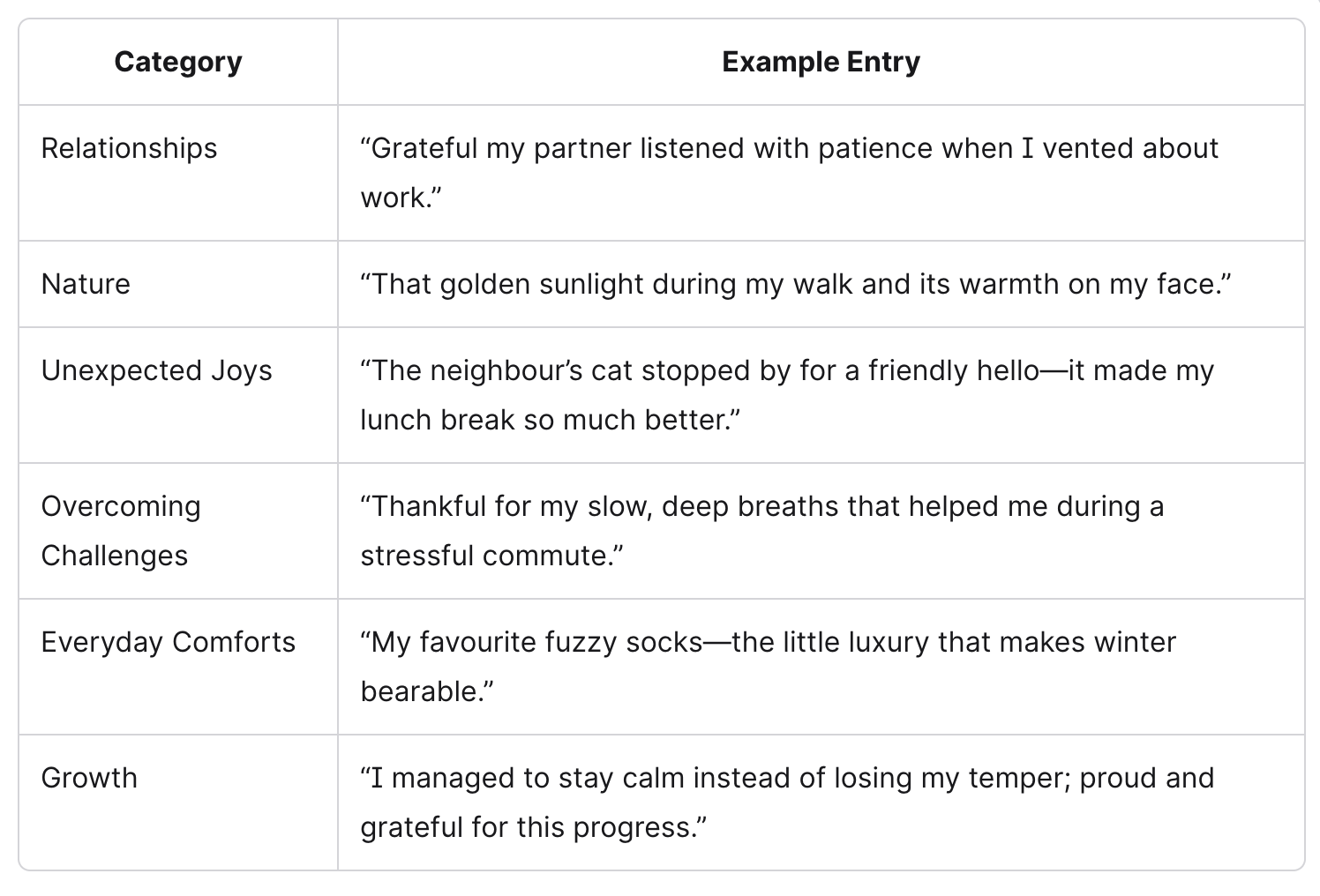If you’ve ever thought about penning down a list of life’s little blessings but didn’t know where to begin, you’re in the right place. Whether you want a happier mind, a lighter heart, or a shield against everyday grumpiness (yes, you—mumbling at your morning coffee), learning how to write a gratitude journal can transform your life in delightful and lasting ways.
Let’s roll up those sleeves, grab your favourite pen (or your fanciest note-taking app), and inject some positivity into your routine—one thank you at a time.
Why Keep a Gratitude Journal?
The Science Behind the Smile
Think a gratitude journal is just self-help fluff? Think again! Research shows that regularly expressing gratitude rewires your brain for optimism, improves mood, and can even help you get a better night’s sleep. It’s not just about woo-woo feelings—your immune system and blood pressure may thank you, too. Gratitude journaling can:
- Boost your happiness
- Lower stress and anxiety
- Strengthen relationships
- Increase resilience during tough times
No, it won’t help you find missing socks or decipher your pet’s inner thoughts. But it can help you see the good in daily chaos—and that’s a superhero power in itself.
How to Write a Gratitude Journal
Choose Your Toolkit—With Intention
The best gratitude journal for you is one you’ll want to reach for—think of it as your “positivity portal.” Consider these options:
- Classic Notebook: A leather journal provides ceremony and tangibility.
- App or Digital Note: Always within reach and easy to back up.
- Loose Papers/Napkins: If you’re spontaneous or prone to late-night revelations.
- Specialised Gratitude Journals: Many offer daily prompts and creative layouts.
Pro Tip: Choose something visually appealing or meaningful, so you’re excited to use it. This isn’t just stationery—it’s your mental spa day!
Set the Scene—Ritual Makes it Real.
Ritual infuses intention. Your journaling spot and routine matter:
- Pick a cosy, distraction-free spot—a favourite armchair, balcony nook, or sunlit corner.
- Pair journaling with another daily habit, like your morning coffee or bedtime tea (bonus: everyone in cafes will wonder about your mysterious smile).
- Make it part of your self-care toolkit—just like yoga, only less stretchy.
Make it a Routine—Consistency > Quantity
You don’t need to write a gratitude novel daily—start small and make it regular:
- 3–5 things: Just a handful each time has proven benefits. Adjust as suits your mood and schedule.
- Schedule it: Mornings can help set a positive tone; evenings can help you wind down with reflection. Pick what fits your lifestyle.
- Forgive missed days: Life gets busy; don’t turn gratitude into a guilt trip.
What to Write in a Gratitude Journal
Be Specific—Go Beyond “Family, Health, Food”
Specificity unlocks the gift:
“I’m grateful for the way my daughter’s laughter echoed through the house when I tried (and failed) to make pancakes this morning.”
This is more impactful than a vague “I’m grateful for my children”—it brings vividness and warmth.
Go for Depth Over Breadth
Five deeply felt entries trump 50 rushed ones:
- Why did this moment matter?
- How did it make you feel?
- What would life be like without it (the subtraction method)?
Explore a gratitude in detail—a gesture, event, or even a lesson from a difficulty.
Get Personal—Celebrate People & Emotions
People often provide our most meaningful gratitude entries:
- “I’m grateful my friend Jamie called just to check in after my tough week.”
- “My partner remembered to pick up my favourite tea.”
Focus on real interactions or small acts of kindness. If you’re grateful for yourself, note it—celebrating your wins is not self-indulgent; it's essential.
Mix It Up with Prompts—Never Get Stuck
Use prompts to keep journaling inspiring rather than repetitive:
- What made me smile today?
- Who surprised me with kindness this week?
- What challenge taught me a valuable lesson?
- What everyday object am I grateful for, and why?
Try gratitude templates or prompts when your brain draws a blank. This keeps the process engaging and ever-fresh.
Don’t Force Perfection—Imperfect is Authentic:
Skipped a day? Wrote just one line? Great! The benefit comes from regular, honest reflection, not from crafting prose worthy of a Pulitzer. Expect variety: some days will be profound, others will be “thank you, coffee.” Both matter.
Pro-Level Tips for Depth & Consistency
- Savour surprises: Unexpected events or joys have extra emotional power.
- See good as “gifts.” Reframe ordinary moments as unique blessings to avoid taking them for granted.
- Reflect on avoided negatives: What pain or hardship did you dodge today?
- Record challenges: Sometimes, gratitude is for lessons learned from tough moments—a broken phone means a humbling reminder of patience!
- Use subtraction: Imagine your life without a person/thing—notice the gratitude bloom.
Aim for variety: Explore different categories: relationships, health, nature, career, creativity, and growth.
Examples of In-Depth Gratitude Journal Entries

More Prompt Ideas
- What was the best part of your day, and why?
- What ordinary object can you not live without?
- Who helped you recently, and how did you thank them?
- What part of your routine brings you peace?
- Name something about your body you appreciate.
- Write a thank you note to yourself—really!
Common Mistakes in Gratitude Journaling (And How to Dodge Them)
1. Going Through the Motions
Mistake: Writing mechanically without any emotional resonance. Listing “grateful for my house, job, and health” without actually feeling it is like eating plain oatmeal every day—sure, it fills you up, but where’s the flavour?
How to Dodge:
Pause after each item. Close your eyes, breathe in, and truly savour the feeling of appreciation. Dwell for a moment on how having these things enriches your life. This emotional presence is the fuel that powers meaningful gratitude.
2. Generalising Without Depth
Mistake: Repeating vague statements like “family, food, house” daily. Repetition drains meaning fast, like re-watching the same episode of your favourite show until you no longer laugh at the jokes.
How to Dodge:
Be specific. Not just “grateful for family,” but “grateful for my brother making me laugh when I needed it most.” Describe why it mattered today, or what it meant to you. The more detail, the more powerful the impact.
3. Waiting for the “Right Time”
Mistake: Believing you need to find the perfect moment, location, or mood to journal. Spoiler: Life rarely rolls out the red carpet for new habits.
How to Dodge:
Just write. Even a few hurried words are better than none. Incorporate gratitude journaling into your routine—tag it onto your morning coffee or wind down before bed. Consistency is gold.
4. Forgetting the Small Moments
Mistake: Focusing only on big, flashy blessings and ignoring micro-joys like the smell of rain or a shared joke.
How to Dodge:
Celebrate the small stuff. Savouring tiny pleasures rewires your brain to spot and appreciate abundance everywhere. Not only does this deepen gratitude, but it prevents your journal from becoming a “best hits” replay.
Tips for Making Gratitude Journaling Stick
Pick a Magic Number
- Why: Too many entries can overwhelm, too few can feel uninspiring.
- Tip: Aim for 3–5 specific things per session. This sweet spot keeps momentum without feeling like a chore.
Use a Template or Planner
- Why: Blank pages intimidate even seasoned writers.
- Tip: Try a gratitude grid, bullet journal, or sprinkle prompts into your planner. Prompts like “What made me smile today?” or “Who helped me this week?” spark creativity and keep things fresh. Consistent templates = easier habit.
Reflect on Challenges
- Why: Growth often hides in discomfort.
- Tip: Journal about tough times or recent struggles. Ask: “What lesson did this situation bring?” Recognising growth and hidden gifts transforms obstacles into sources of gratitude.
Celebrate Surprises
- Why: Unexpected joys pack an extra emotional punch.
- Tip: Give special attention to unplanned acts of kindness, lucky breaks, or moments of unexpected beauty. These can turn routine days into memorable ones and reignite your sense of wonder.
Pro-Level Strategies
- Mix It Up: Avoid monotony by writing about different categories—relationships, health, nature, personal wins, and growth.
- Forgive Inconsistency: Missed days happen. Just return to your journal, no guilt required.
- Don't Over-Complicate: Keep routines simple; perfection is not the point, genuine reflection is.
- Be Kind to Yourself: Avoid critical self-judgment if an entry feels bland or if you skip a day. Celebrate your return to the habit instead.
Final Perspective
Gratitude journaling isn't about crafting literary masterpieces or logging endless lists—it's about tuning in to genuine moments, big and small, and savouring their gifts. Presence, specificity, and a willingness to embrace both the sunny and the stormy make for a practice that truly sticks and transforms.

.png)
.png)
.jpg)



